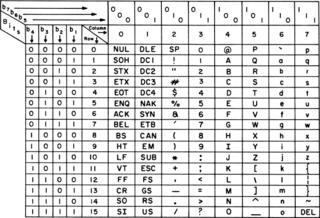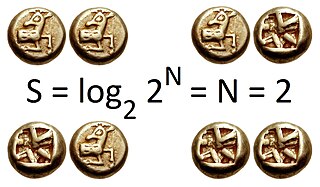
ASCII, abbreviated from American Standard Code for Information Interchange, is a character encoding standard for electronic communication. ASCII codes represent text in computers, telecommunications equipment, and other devices. Most modern character-encoding schemes are based on ASCII, although they support many additional characters.
The bit is a basic unit of information in information theory, computing, including digital communications. The name is a portmanteau of binary digit.
The byte is a unit of digital information that most commonly consists of eight bits. Historically, the byte was the number of bits used to encode a single character of text in a computer and for this reason it is the smallest addressable unit of memory in many computer architectures.
Extended Binary Coded Decimal Interchange Code is an eight-bit character encoding used mainly on IBM mainframe and IBM midrange computer operating systems. It descended from the code used with punched cards and the corresponding six-bit binary-coded decimal code used with most of IBM's computer peripherals of the late 1950s and early 1960s. It is supported by various non-IBM platforms, such as Fujitsu-Siemens' BS2000/OSD, OS-IV, MSP, and MSP-EX, the SDS Sigma series, Unisys VS/9, Burroughs MCP and ICL VME.

In computing, floating-point arithmetic (FP) is arithmetic using formulaic representation of real numbers as an approximation to support a trade-off between range and precision. For this reason, floating-point computation is often found in systems which include very small and very large real numbers, which require fast processing times. A number is, in general, represented approximately to a fixed number of significant digits and scaled using an exponent in some fixed base; the base for the scaling is normally two, ten, or sixteen. A number that can be represented exactly is of the following form:

Information entropy is the average rate at which information is produced by a stochastic source of data.
A universal asynchronous receiver-transmitter is a computer hardware device for asynchronous serial communication in which the data format and transmission speeds are configurable. The electric signaling levels and methods are handled by a driver circuit external to the UART. A UART is usually an individual integrated circuit (IC) used for serial communications over a computer or peripheral device serial port. One or more UART peripherals are commonly integrated in microcontroller chips. A related device, the universal synchronous and asynchronous receiver-transmitter (USART) also supports synchronous operation.

A magnetic stripe card is a type of card capable of storing data by modifying the magnetism of tiny iron-based magnetic particles on a band of magnetic material on the card. The magnetic stripe, sometimes called swipe card or magstripe, is read by swiping past a magnetic reading head. Magnetic stripe cards are commonly used in credit cards, identity cards, and transportation tickets. They may also contain an RFID tag, a transponder device and/or a microchip mostly used for business premises access control or electronic payment.

In computer architecture, 36-bit integers, memory addresses, or other data units are those that are 36 bits wide. Also, 36-bit CPU and ALU architectures are those that are based on registers, address buses, or data buses of that size. 36-bit computers were popular in the early mainframe computer era from the 1950s through the early 1970s.
In computing, a word is the natural unit of data used by a particular processor design. A word is a fixed-sized piece of data handled as a unit by the instruction set or the hardware of the processor. The number of bits in a word is an important characteristic of any specific processor design or computer architecture.
RADIX-50, commonly called Rad-50, RAD50 or DEC Squoze, is an uppercase only character encoding created by Digital Equipment Corporation for use on their DECsystem, PDP, and VAX computers. RADIX-50's 40-character repertoire can encode six characters plus four additional bits into one 36-bit word ; three characters plus two additional bits into one 18-bit word ; or three characters into one 16-bit word.
The octet is a unit of digital information in computing and telecommunications that consists of eight bits. The term is often used when the term byte might be ambiguous, as the byte has historically been used for storage units of a variety of sizes.

The Socialist Federal Republic of Yugoslavia (SFRY) was a socialist country that existed in the second half of the 20th century. Being socialist meant that strict technology import rules and regulations shaped the development of computer history in the country, unlike in the Western world. However, since it was a non-aligned country, it had no ties to the Soviet Bloc either. One of the major ideas contributing to the development of any technology in SFRY was the apparent need to be independent of foreign suppliers for spare parts, fueling domestic computer development.
Iskra Delta 800 was a PDP-11/34-compatible computer developed by Iskra Delta in 1984.

Iskra Delta was a computer manufacturer from Slovenia, and one of the biggest computer producers in SFR Yugoslavia that saw its own end with the breakup of the country. It started in 1974 as Elektrotehna, the Ljubljana representative of Digital Equipment Corporation, a USA minicomputer manufacturer with an office in Belgrade. It began assembling PDP-11 minicomputers in Ljubljana from DEC processors and Ampex disks in 1978. Rapid expansion over all major Yugoslav Republics. It had a joint venture with Energoinvest, Sarajevo. Video terminals assembly was in Paka, Slovenj Gradec. Forced merger with Iskra and Gorenje computer divisions resulted in Iskra-Delta's enlargement to 2,000 employees. Delays with microcomputer technology and freer import brought its collapse in 1988. As always, the real reasons are deeper and hidden from public eye. It was disclosed recently that Iskra-Delta with Energoinvest installed computer network of 17 USA VAX computers to Chinese secret police in 1985. Export license was given under premise of preventing bicycles theft. DEC and CIA cancelled representation agreement soon after that. The life and fall of one of the biggest IT companies of the time in Europe, is best described in the book written by Delta's former CEO, Janez Škrubej. It is not exaggerated to say that the company was the victim of the cold war as much as domestic corrupted politicians in service of foreign powers.
YUSCII is an informal name for several JUS standards for 7-bit character encoding. These include:

Triglav was a computer from Slovenia developed in the 1980s and manufactured by Iskra Delta. It came to the market in 1985. It had options for three different central processing units and could therefore run several different operating systems that were popular at the time. Also supported was a hard drive with a capacity between 40 and 80 MB, 5.25" floppy drive and a microstreamer tape drive.

Extended ASCII character encodings are eight-bit or larger encodings that include the standard seven-bit ASCII characters, plus additional characters. Using the term "extended ASCII" on its own is sometimes criticized, because it can be mistakenly interpreted to mean that the ASCII standard has been updated to include more than 128 characters or that the term unambiguously identifies a single encoding, neither of which is the case.
BCD, also called alphanumeric BCD, alphameric BCD, BCD Interchange Code, or BCDIC, is a family of representations of numerals, uppercase Latin letters, and some special and control characters as six-bit character codes.








